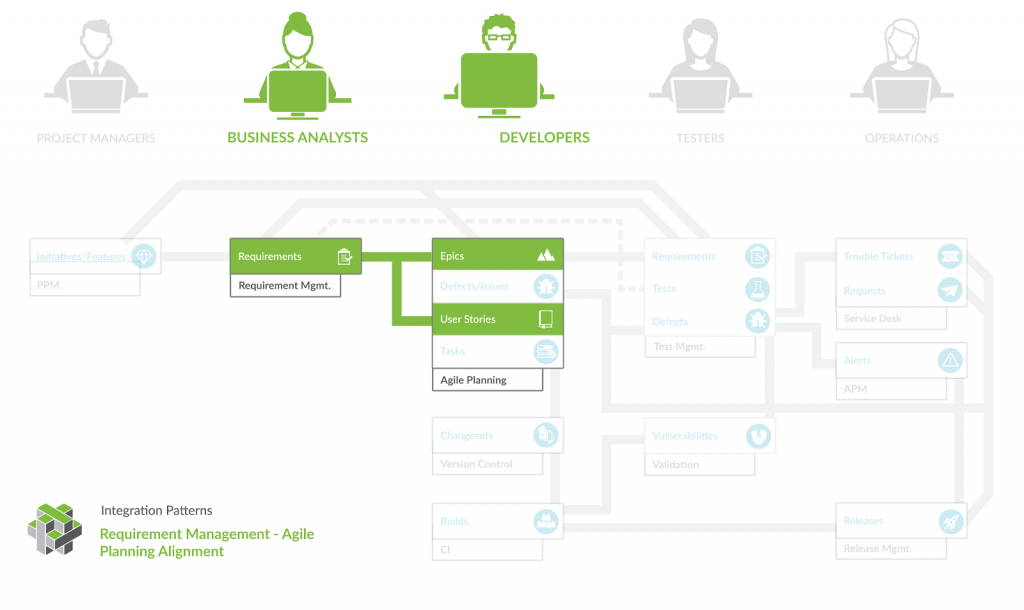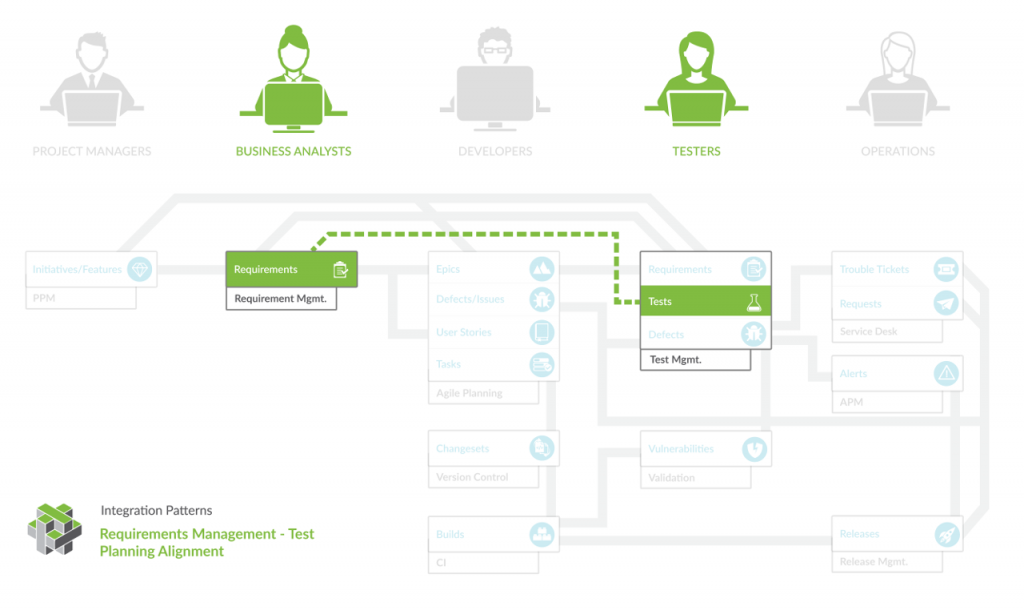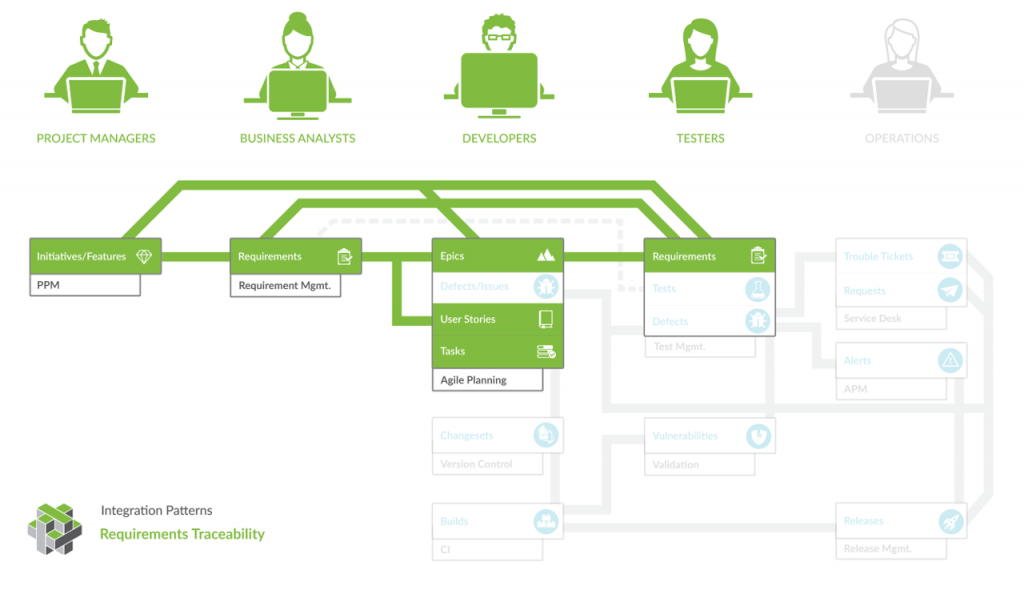How to bring requirements management and software integration together
With the complexity of products being built today, no one person can understand all the pieces. Yet everyone involved is still responsible for ensuring their work is compatible with co-workers and aligns with the company’s strategy. The only way to keep everyone moving toward the same goal is to have a shared understanding of what’s being built and why. This is where requirements management and software integration comes in.
Requirements define what a product should be. Equally important, though, they’re the single shared communication bridge between all disciplines. Everything involved in the pursuit of product development can be tied back to the definition of what you’re building — otherwise there’s misalignment somewhere. The goals of the market-facing teams translate into product requirements, making abstract desires achievable. The effort of design, development, and testing teams are driven by requirements. Product documentation, software integration, marketing, and spec all tie back to requirements at the end of a project, all derived from the same set of goals.
However, the relationship between requirements and everyone else’s work is not always easily visible. There might be degrees of separation, such as many levels of decomposition from market goals down to tasks. Information may be kept in multiple task-specific tools. While a shared understanding — in the form of requirements — is essential for alignment, it’s not sufficient in many cases. Companies with complex, multi-level, cross-tool product data run the risk of creating silos and disconnects from the original product goal.
This is why software integration and requirements management work hand-in-hand to realize the full potential of collaboration. When managed effectively, requirements are dynamic. Thoughtful integrations facilitate timely communication between those defining the product goals and those building the product, so those changes on either side are visible and part of continuous decision making.
Aligning teams with value stream networks
While it’s tempting to think of product delivery as a linear process of sequential steps, in reality it’s much more like a chaotic, organic network. Activities occur in tandem, spanning many parts of the organization. Requirements can change after implementation has begun, and modifications made to one part of the process can have far-reaching impacts to several different teams. It should be no surprise, then, that the root cause of failure in product development can be traced to an under-connected value stream network.
A value stream is a notion borrowed from lean manufacturing; it’s the sequence of activities an organization undertakes to deliver a customer request, focusing on both the production flow from raw material to end-product, and on the design flow from concept to realization. Counter to our common understanding, product management should be viewed as a value stream network, rather than simply as a value stream, as the process truly consists of many activities that occur in conjunction, overlap, and influence one another. In order to be truly successful, your value stream network must have a high level of connectivity between each node (or team) within your organization.
Given that requirements are central to driving actions and decisions throughout the product lifecycle, key challenges arise when they’re not integrated and easily accessible to all teams throughout the organization. Despite relying on separate, purpose-driven tools, each team must be able to access the same information in order to work cohesively. And that information isn’t static. Because of the dynamic nature of requirements, it’s essential that each team be able to review and absorb any modifications made to the requirement in real time. That’s where integration comes in.
While each organization is unique, our experience has allowed us to uncover several common software integration patterns. In many cases, these patterns can build on one another to create a cohesive network of connection throughout an organization.
When getting started, we recommend that organizations first identify the scenarios that are causing the most immediate pain, and enable the associated integration patterns to ameliorate that pain. Over time, organizations can adopt and deploy more and more of these integration patterns, to work toward a wholly unified and cohesive value stream network.
Requirements management and Agile planning alignment
Often, business analysts and product managers create and manage requirements in a requirements management tool, such as Jama Software or IBM DOORS. If their organization uses agile methods, the development team may expect to see those requirements within an agile planning tool, such as JIRA or CA Agile Planning, where they can manage them and further break them down into user stories for execution.
In this pattern, requirements flow from the requirements tool to the agile planning tool as epics or features. They can then be broken down into user stories or sub-tasks while doing agile with the planning tool. If desired, teams can maintain the relationship between the epic and its subtasks when flowing that data back to the requirements tool.
Software integration and test planning alignment
In order to create their test plans, QA teams must have access to the requirements for each feature. The problem is that requirements and user stories are usually created by business analysts and product managers in a tool such as Jama or IBM DOORS, while QA teams create their test plans, test cases, and test scripts in another set of tools, such as HPE QC or Tricentis Tosca. By flowing requirements from the product team’s requirements tool to the QA team’s testing tool as test cases, organizations are able to keep these two teams aligned, while allowing each to use their own tool of choice. This eliminates the risk of miscommunication or bottlenecks as teams are able to seamlessly flow information on acceptance criteria, test status, and more between each tool.
Tracing requirements
Requirements, epics, and user stories span multiple disciplines and tools in the product development and delivery process. No matter where they’re created and managed, there are many distinct stakeholders who may need access to them. For this reason, “requirements traceability” can be viewed as a composite pattern, composed of several smaller integration patterns.
For example, a project manager may manage project deliverables within a PPM tool, which then flow to a business analyst’s requirements management tool. Once the business analyst has determined the scope and details of the deliverable, that information flows to the developer’s tool as an epic, which is further broken down into user stories and tasks. That epic then flows to the QA team’s testing tool to ensure that the testers understand the requirements that they’re testing. In this way, four separate teams are able to share information and collaborate, all within their own purpose-built tools and practices. By making use of each team’s existing processes and practices, they’re able to eliminate wasted ramp-up time needed to gain access and proficiency in each tool, while allowing each team to use the systems that best facilitate their unique goals.
While there’s always been a need for integration, managing complex, dynamic requirements makes it all the more necessary. In order to demonstrate product compliance and auditability, practitioners must relate their features, test cases, and other work items back to the original compliance requirements.
Without integration, practitioners must spend valuable time on status calls, communication via e-mail, and on double-entry between systems, leaving them no time to do the work they were actually hired to do: the design, development, and quality assurance tasks needed to create and ship their product.
Harnessing requirements management and software integration
Integration serves as the glue between these separate disciplines, people, and tools. And when the integrations are domain-aware, they can do seemingly magical things like translate between tools that have conceptual and technical mismatches. Smart integrations are able to translate different work item types and field values between tools in order to facilitate communication between teams, regardless of differences in tool architecture.
Recognizing the inherent network that connects teams in an organization is the first step to enhancing product development. Once you’re able to identify the key areas where teams must share information, you’ll be able to navigate areas in which communication breakdowns are occurring. By implementing key software integration patterns, you’ll increase connectivity between each node of your organizational network. And as connectivity increases and, with it, each team’s ability to access key requirements, you’ll see enhanced success within your organization.
Co-author Rebecca Dobbin is a Product Analyst with Tasktop Technologies (@rebecca__dobbin)
Co-author Robin Calhoun is a Product Manager for Jama Software





